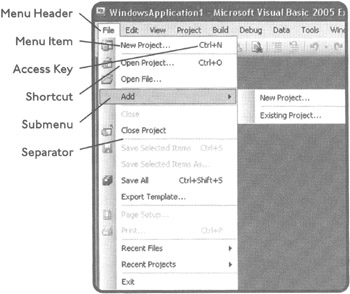DESIGNING A MENU SYSTEM
One of the most basic features of any Windows application is its menu system. A menu system provides an intuitive and convenient means for organizing the commands that make your Visual Basic applications work.
A menu system is also a great space saver. It sits conveniently at the top of your application window and takes up very little space. In fact, it only takes up space when you access it, and then it closes back up automatically when you are done with it. A menu system frees up valuable space by allowing you to remove buttons and other types of controls that would otherwise be required.
Figure 4.7 shows a typical Windows application's menu system. As you can see, it consists of many different features.

Figure 4-7: Examining the contents of the Visual Basic Express 2005 File menu.
Windows application menu systems generally consist of one or more of the following six menu features, each of which is visible in Figure 4.7. These six menu features include:
-
Menus. These are the first, or high level, menu items that are immediately visible from the menu bar (for example, File, Edit, Help, and so on).
-
Menu items. These are additional menu items residing under menus, each of which represents a choice that can be made by users.
-
Submenus. These are collections of menu items accessed through a parent menu item. Submenus can be identified by the black arrow on the right end of the menu item that provides access to them.
-
Shortcuts. These are keyboard characters, such as the F1 key, that can be used to access menu items.
-
Access Keys. These are keyboard keys that, when used in conjunction with the Alt key, activate a menu or menu item.
-
Separators. These are horizontal lines used to organize menu items into logical groups.
Today, most users are sophisticated and experienced enough with Microsoft Windows that they have come to expect that all Windows applications work in certain ways. Any application that fails to meet these expectations, no matter how good it may be, runs the risk of disappointing its target audience. One expectation that most Windows users have is that all Windows application menus should follow a predictable formula. By this I mean that users expect to see menu headings such as File, Edit, and Help. For example, the File menu is generally listed first, and Help is listed last. Menu items for opening, closing, printing, exiting, and so on typically are located on the File menu. In addition, the last menu item on the File menu should be an Exit command. Unless you have a compelling reason for not following this formula, I strongly recommend against varying from it.
EAN: 2147483647
Pages: 126